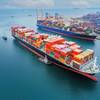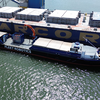Safer Navigation with International Standards for Electronic Systems
Carrying an estimated 90% of world trade and billions of passengers every year, international shipping represents the life blood of the global economy. Safety, always a major concern for seafarers, has made huge advances in the last century. However, the massive increase in traffic in recent decades requires, among other things, new or better global communication and navigation solutions resting on internationally-agreed standards to maintain and improve safety levels.
Shipping was among the very first industries to adopt widely implemented international safety standards. These cover equipment that may break down, catch fire or explode, and systems enabling a ship's crew to chart its way, know its position, minimize risks of collisions and grounding, and communicate with other vessels and shore.
Because of its inherently global nature, the safety of shipping is regulated by various specialized United Nations and other agencies.
The International Maritime Organization (IMO), the UN agency with responsibility for the safety and security of shipping and the prevention of marine pollution by ships, has developed a comprehensive framework of international safety regulations enforced globally. Of particular importance is the International Safety of Life at Sea (SOLAS) Convention.
Delegating Standardization
There is a need for international agreement on standards in the shipping industry to avoid duplication and eliminate unnecessary barriers to trade, as well as ensuring it operates safely, predictably, and as freely as possible.
The IMO does not generally produce detailed technical and test standards for maritime navigation and radiocommunications equipment and systems. The International Electrotechnical Commission (IEC) is the world’s global standardization body for electrotechnology. Its Technical Committee 80: Maritime navigation and radiocommunications equipment and systems, prepares international standards for these, in agreement with the IMO.
From Morse Code to SatCom
Communication with ships was actually the first application of radio at the end of the 19th century. Ships started installing radio equipment for their operations and these also gradually came to be used for distress and safety purposes, relying on wireless telegraphy and Morse code. The earliest and most famous example of such use was the distress message sent by the Titanic exactly 100 years ago. Morse code was phased out in 1999 to be replaced by the IMO-developed Global Maritime Distress and Safety System (GMDSS) that uses radio and satellite communications equipment. GMDSS enables ships to communicate with shore stations from anywhere at sea and at any time. Its requirements form part of SOLAS, making it an essential tool for search and rescue (SAR) operations.
Keeping Off the Rocks
For centuries, ships have relied on nautical charts and instruments like compasses or sextants for safe navigation and positioning. Electronic equipment such as radar and sonar was introduced from the 1930s, initially on naval ships, to provide data on distance to and from other ships and shores and on navigational depth.
In recent years, significant changes have been phased in to the navigation equipment carried by ships. They now carry and rely upon improved radar equipment and automatic position fixing provided by satellite navigation systems.
This year also sees the introduction of a program for the mandatory carriage of electronic charts in the form of an IMO system called Electronic Chart Display and Information System (ECDIS), a computer-based navigation information system that can be used instead of paper nautical charts and integrates positioning information from satellites.
The first edition of standards for ECDIS, IEC 61174, was published in 1998; it is now on its third edition, reflecting the increased experience of use in the field and detailed changes to IMO requirements. ECDIS is not only fundamentally changing the way in which ships navigate but has also highlighted the evolution in a ship’s bridge equipment, which is becoming increasingly complex and software-dominated, requiring constant updates.
The mandatory carriage of ECDIS certainly highlights the issues of software maintenance to the many shipping companies who still have a ‘fit-and-forget’ attitude to bridge equipment.
The International Hydrographic Organization (IHO), an intergovernmental organization representing the hydrographic community, recently updated its standard for electronic navigation charts and will complete work on the next generation of standards for electronic navigation chart databases in the next few years. This will lead to more changes in IEC standards for ECDIS and the presentation of charted information.
To See and Be Seen
An Automatic Identification System (AIS) has been introduced which allows ships to provide information about them automatically to other ships and to coastal authorities. Regulations that come into force at the beginning of July 2012 require that AIS be fitted aboard all new build passenger ships of 300 gross tonnage (GT) and upwards and to new cargo ships of 500 GT and upwards. In both cases, the regulations apply to ships engaged on international voyages.
Voyage data recorders, comparable with the so-called black boxes found on commercial aircraft, have been installed to record and protect ship data and voice recordings which can be recovered and analysed after an accident.
This year also sees the start of a phase-in programme for the carriage of a Bridge Navigational Watch Alarm System (BNWAS) designed to ensure that the bridge team is alert to the task and has not become incapacitated in any way. Automation of ship functions has resulted in vessels carrying fewer and fewer crew; even large ships may now be crewed by as few as 13 personnel.
Recent and Active IEC Technical Committee
IEC TC 80, which prepares International Standards for the shipping industry, was set up in 1980 and has produced some 50 standards so far, not only supporting IMO requirements, but also for more general ship and shore applications. They also enable interoperability of equipment on different types of vessels which share the same radio spectrum and enable the interconnection of equipment on a vessel for the exchange of data.
The TC’s objective is to publish standards that gain international acceptance as suitable for type approval where required by the SOLAS Convention and certification where required by the International Telecommunication Union (ITU), another UN specialized agency that sets the basic standards for radio communications and the safeguarding of the radio frequency spectrum used by the shipping industry.
By being represented in both the IMO and the ITU, IEC TC 80 is able to influence the performance and technical content of those agencies' work. This is invaluable to equipment manufacturers, in that the performance and technical standards represent the practical state of the current and emerging technology.
State-of-the-Art for High-Value Assets
Ships are technically very sophisticated, high value assets, and one of the fundamental trends in the maritime industry has been an increasing reliance on electrical and electronic technologies for navigation and communication. These technologies have moved well out of the mechanical era of the magnetic and gyro compass and into the electronic and information age. The bridge of a ship is now a dense concentration of navigation, communication and machinery control equipment, all of which has to work together.
Around 6% of a ship's total manufacturing cost is attributable to the navigation and communication equipment in the vessel. This gives a valuable world market worth $1.7 billion for merchant ships, $0.5 billion for fishing vessels and $1.3 billion for pleasure craft.
Future Trends Improving Collaboration
The major trend in technology is an increasing focus on improving collaboration within the bridge team, between the bridge team and pilot and with shore-side sources of information. Associated with this is the development of smarter interfaces between navigation sensors and bridge workstation applications. This is leading to new developments for data transfer via Local Area Networks (LAN) and for Bridge Alert Management for handling alarms.
Changes introduced by the ITU in radio-frequency allocations and maximum acceptable levels of out-of-band emissions are promoting development of navigation radars not based on pulsed-magnetron designs.
The IMO has now embarked on a major program called E-navigation. This is intended to integrate existing and new navigational tools, in particular electronic tools, in an all-embracing system that will contribute to enhanced navigational safety and operational efficiency while simultaneously reducing the burden on the navigator and taking account of environmental issues.
For Safer Future Sailing
IEC TC80 expects to see a significant increase in new standards development and liaison activity. This will be driven by the increased mid-ocean coverage of broadband satellite communications, new capabilities of satellite systems in low earth orbit, the potential of eLoran (enhanced electronic navigation) as an affordable alternative technology backup to satellite navigation systems for position/time reference, and by the potential offered by digital radio for cooperative use of the radio frequency spectrum. IEC TC 80 will continue to support the IMO with the development of new or updated standards for ship bridge equipment and such systems as GMDSS, AIS, ACDIS, BNAWS, and shipborne Long-Range Identification Tracking. Work is currently under way on updating existing standards and preparing more than a dozen standards across all these systems. A busy agenda for the coming years and beyond that will ensure shipping becomes even safer.
Morand Fachot, a technical writer with the International Electrotechnical Commission (IEC), worked before as a BBC journalist, writing also for the Financial Times Business Group and several international publications
Links:
IMO: International Maritime Organization
http://www.imo.org/Pages/home.aspx
IEC http://www.iec.ch
IEC TC 80: Maritime navigation and radiocommunication equipment and systems
http://www.iec.ch/dyn/www/f?p=103:7:0::::FSP_ORG_ID:1271
ITU: International Telecommunication Union
http://www.itu.int
IHO: International Hydrographic Organization
http://www.iho.int
(As published in the June 2012 edition of Maritime Reporter & Engineering News - www.marinelink.com)













